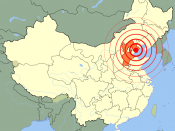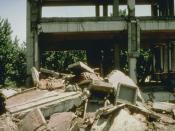The Tangshan Earthquake:
The deadliest earthquake to strike in the twentieth century occurred on July 28, 1976 near the east coast of the Republic of China. The epicenter was at the city of Tangshan, in the Hebei province, about 90 miles southeast of Beijing; the hypocenter was directly under the city at a depth of 11 km. The initial tremor was a magnitude 8.2 followed by an aftershock of a magnitude 7.8. Although the 1964 Alaska earthquake was a magnitude 8.4, the damage it caused was far exceed in Tangshan, where great losses of life and property were suffered. However, China's political isolation and strict governmental control of information makes accurate analysis of the earthquake difficult. Few foreigners were allowed into the country, and nonChinese sources of information were primarily anecdotal. Nearly twenty years later, political changes within China have resulted in the surfacing of new information which sheds light on the following factors which contributed to making the Tangshan quake so devastating, 1) the geology of the quake, 2) the timing of the quake, 3) the inadequacy of the building codes, 4) the damaged infrastructure which hindered rescue efforts, 5) the great loss of human life, and 6) perhaps the most important of all, human dereliction.
Geology of the Tangshan Earthquake:
Tangshan's geographic location makes it particularly vulnerable to earthquakes, on both a regional and local scale. Just three weeks after the Tangshan quake, over a two-day period, China's Szechwan Province, the Philippine island of Mindanao, and Japan's Honshu Island were all struck by earthquakes (Rollins and Bryant). The Indian plate and the Pacific plate are squeezing the Asian continent. As the Indian plate moves northeastward, it pushes on the Asian continent. The Pacific plate is squeezing the Asian continent from the east (Figures 1 and 2). The steep...


